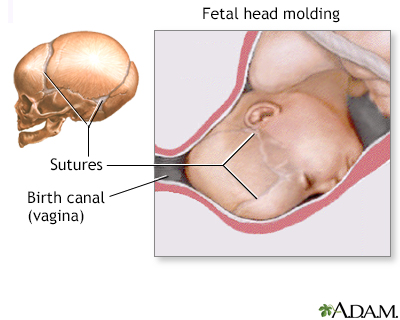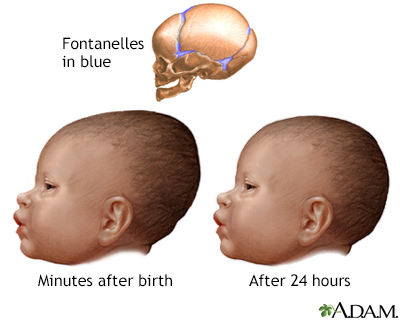Newborn head molding
Newborn cranial deformation; Molding of the newborn's head; Neonatal care - head molding
Newborn head molding is an abnormal head shape that results from pressure on the baby's head during childbirth.
Images



Information
The bones of a newborn baby's skull are soft and flexible, with gaps between the plates of bone.
The spaces between the bony plates of the skull are called cranial sutures. The front (anterior) and back (posterior) fontanelles are 2 gaps that are particularly large. These are the soft spots you can feel when you touch the top of your baby's head.
When a baby is born in a head-first position, pressure on the head in the birth canal may mold the head into an oblong shape. These spaces between the bones allow the baby's head to change shape. Depending on the amount and length of pressure, the skull bones may even overlap.
These spaces also allow the brain to grow inside the skull bones. They will close as the brain reaches its full size.
Fluid may also collect in the baby's scalp (caput succedaneum), or blood may collect beneath the scalp (cephalohematoma). This may further distort the shape and appearance of the baby's head. Fluid and blood collection in and around the scalp is common during delivery. It will most often go away in a few days.
If your baby is born breech (buttocks or feet first) or by cesarean delivery (C-section), the head is most often round. Severe abnormalities in head size are not related to molding.
Related topics include:
- Craniosynostosis
- Macrocephaly (abnormally large head size)
- Microcephaly (abnormally small head size)
References
Ball JW, Dains JE, Flynn JA, Solomon BS, Stewart RW. Head and neck. In: Ball JW, Dains JE, Flynn JA, Solomon BS, Stewart RW, eds. Seidel's Guide to Physical Examination. 10th ed. St Louis, MO: Elsevier; 2023:chap 11.
Fulton GK, Blessing MS, Evans KN. Craniofacial conditions. In: Gleason CA, Sawyer T, eds. Avery's Diseases of the Newborn. 11th ed. Philadelphia, PA: Elsevier; 2024:chap 88.
Jones KL, Jones MC, del Campo M. Craniosynostosis syndromes. In: Jones KL, Jones MC, del Campo M, eds. Smith's Recognizable Patterns of Human Malformation. 8th ed. Philadelphia, PA: Elsevier; 2022:570-599.
Lissauer T, Hansen A. Physical examination of the newborn. In: Martin RJ, Fanaroff AA, Walsh MC, eds. Fanaroff and Martin's Neonatal-Perinatal Medicine. 11th ed. Philadelphia, PA: Elsevier; 2020:chap 28.
BACK TO TOPReview Date: 11/6/2023
Reviewed By: Neil K. Kaneshiro, MD, MHA, Clinical Professor of Pediatrics, University of Washington School of Medicine, Seattle, WA. Also reviewed by David C. Dugdale, MD, Medical Director, Brenda Conaway, Editorial Director, and the A.D.A.M. Editorial team.

Health Content Provider
06/01/2025
|
A.D.A.M., Inc. is accredited by URAC, for Health Content Provider (www.urac.org). URAC's accreditation program is an independent audit to verify that A.D.A.M. follows rigorous standards of quality and accountability. A.D.A.M. is among the first to achieve this important distinction for online health information and services. Learn more about A.D.A.M.'s editorial policy, editorial process and privacy policy. A.D.A.M. is also a founding member of Hi-Ethics. This site complied with the HONcode standard for trustworthy health information from 1995 to 2022, after which HON (Health On the Net, a not-for-profit organization that promoted transparent and reliable health information online) was discontinued. |
The information provided herein should not be used during any medical emergency or for the diagnosis or treatment of any medical condition. A licensed medical professional should be consulted for diagnosis and treatment of any and all medical conditions. Links to other sites are provided for information only -- they do not constitute endorsements of those other sites. © 1997- 2024 A.D.A.M., a business unit of Ebix, Inc. Any duplication or distribution of the information contained herein is strictly prohibited.
